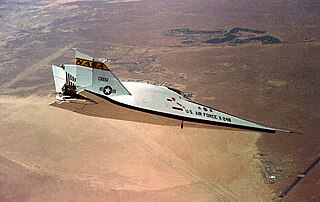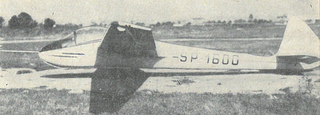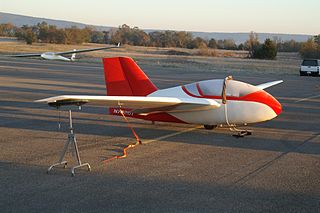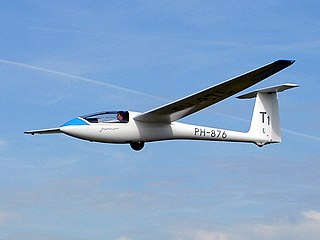
The Martin Marietta X-24 was an American experimental aircraft developed from a joint United States Air Force-NASA program named PILOT (1963–1975). It was designed and built to test lifting body concepts, experimenting with the concept of unpowered reentry and landing, later used by the Space Shuttle. Originally built as the X-24A, the aircraft was later rebuilt as the X-24B.

The ASW 19 is a single-seat glider built by Alexander Schleicher GmbH & Co, first flying in 1975. It was originally designed as a Standard Class glider, but now mainly competes in the Club Class. The ASW 19 is known for its pleasant handling and some clubs use it as a training glider. It was succeeded by the all-new Schleicher ASW 24.

The Rutan VariViggen is a homebuilt aircraft designed by Burt Rutan. The aircraft is a tandem two-seater of primarily wooden construction with a delta wing and a canard foreplane. The VariViggen is powered by a 150 hp Lycoming O-320 aero engine in pusher configuration. The prototype was designated Model 27, and the production version was Model 32.

The Bellanca 19-25 Skyrocket II was a prototype light airplane built in the United States in the 1970s. Despite its advanced design and exceptionally good performance, it never achieved certification or entered production.
The Fike Model D was a light aircraft built in the United States in the early 1950s. Designed by airline pilot William Fike, it was a conventional high-wing strut-braced monoplane with tailskid undercarriage and seating for one or two people in an enclosed cabin. In appearance, the aircraft strongly resembled a Piper Cub, with only the tail surfaces sourced from one. An unusual feature was that the flight controls were mounted to the ceiling of the cabin, rather than the floor. This facilitated the folding or removal of the seat or seats to enable the aircraft's use as a sleeping space when camping with it. Plans were marketed for homebuilding.

The Italair F.20 Pegaso was a twin-engine utility aircraft designed by Stelio Frati and built in Italy in 1971.

The SZD-11 Albatros was a single-seat glider aircraft that was designed and built in Poland at Szybowcowy Zakład Doświadczalny - Glider Experimental Works in Bielsko-Biała in 1954. Only one prototype was completed and flown.

The Stout Skycar was a series of four one-off American light aircraft of the 1930s.
The Fisher Culex and Culite are a family of American two-seat, twin-engined monoplanes. The aircraft is supplied in the form of blueprints for amateur construction, originally by Fisher Flying Products and now by Mike Fisher Aircraft.

The Marske Pioneer is a family of American, single-seat, mid-wing, tailless gliders that was designed by Jim Marske. The Pioneer II version was available as plans and in kit form from Marske Aircraft Corporation for amateur construction.

The PZL Bielsko SZD-51 Junior is a Polish single-seat training and club sailplane.
The Shober Willie II is an American two-seat sporting or aerobatic aircraft designed and built by Shober Aircraft Enterprises. The aircraft was designed to be sold as plans for amateur construction.
The HPA Toucan is a British two-seat man-powered aircraft built and flown by members of Hertfordshire Pedal Aeronauts and was the first two-man man-powered aircraft to fly.

The Akaflieg Stuttgart fs26 Moseppl is a German single-seat motor glider with twin fins and rudders designed and built by Akaflieg Stuttgart. First flown on the 25 September 1970 it was designed as an experiment and not intended for production.
The Ryson STP-1 Swallow is an American experimental two-seat powered cruising sailplane designed and built by the Ryson Aviation Corporation to be license built by other companies.
The Manuel Hawk was a homebuilt single-seat glider designed and constructed in the UK around 1970. Only one example was flown.
The Airborne Avenger is an American ultralight aircraft that was designed and produced by Airborne Wing Design in the early 1980s. The aircraft was supplied as a kit for amateur construction.
The PAM 100B Individual Lifting Vehicle was an American lifting vehicle designed and built in the early 1990s by the Performance Aviation Manufacturing Group of Williamsburg, Virginia, it is also designed for amateur construction from a kit of parts. As of 2003, a UAV variant of the design was reportedly being developed in 2001.
The North Wing Apache is an American two-seat ultralight trike designed and produced by North Wing Design of East Wenatchee, Washington. The aircraft is supplied as a kit for amateur construction.

The SZD-42 Jantar 2 is a single seat Open Class competition glider, designed and produced in Poland in the 1970s. It features a span of over 20 m (66 ft) and elastic, camber changing flaps. It was placed second, third and seventh at the 1976 World Gliding Championships. Over one hundred were built and more than ninety remain registered.











